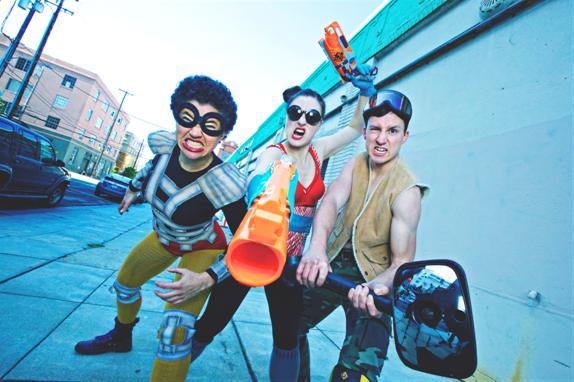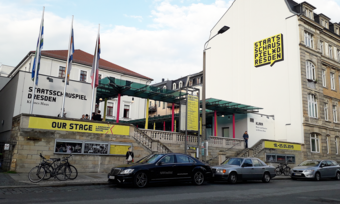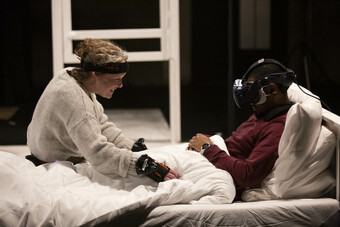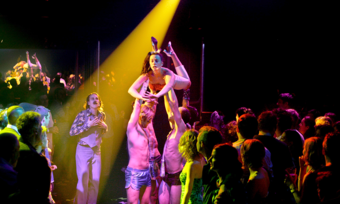Confounding and Creating
At Play with Audience Expectations
Consider, if you would, three scenarios:
In the first, you approach an office building. As you walk up the steps, you check the address: yes, this is where you were instructed to come when you made your appointment. Upon stepping inside an open-plan space filled with desks, a smiling receptionist says, “Welcome to Wake Up Horizons.” She takes your name and escorts you to the waiting area, where you sit until your representative is ready to speak with you.
In the second, you meander down an urban street full of pedestrians in the cool spring night. Down an alleyway, something catches your eye: a small platform has been set up, with three black umbrellas hovering over ghostly figures lit by bare bulbs hanging from inside the umbrellas. You step forward for a closer look. Across from two faceless men in black suits, each under an umbrella, sit two people in street clothes. A woman approaches you with a clipboard and asks if you would like to take your turn with one of the faceless men.
Finally, you step into the lobby of a theater. You feel festive, abuzz with the vibrance that accompanies entering the familiar unknown of a new play. You approach the box office, give your name. Tickets slide across the counter; money slides across in the other direction. The house opens and you enter, find your seat. You remove your coat, study the set, make predictions about the piece based on what you see, turn off your cell phone, wave to someone you recognize. The houselights fade and you settle in.
Each of these scenarios describes a representative experience of someone who has attended in the past year a performance by Mugwumpin, the performance company that I cofounded and direct. I begin by discussing that liminal moment at which you begin engaging with each piece, because this is the moment at which audience expectations are ripest. I am fascinated by that parti-colored elephant, that wispy aurora theatralis, that is the set of expectations, conscious or unconscious, of every attendee at a performance.
It’s a commonplace these days (or, at least, it should be) that everyone who engages with a work of art is committing his or her own act of creation; engagement demands interpretation, personalization, the drawing of connections between one’s own experience and the work of art. In the words of philosopher Jacques Rancière, the spectator “makes his poem with the poem that is performed in front of him.” Theater is a particularly fertile discipline for inviting creative acts from the audience, because the general paucity of our means (even in the largest of houses) demands that the audience fills in the gaps in our patchwork with imaginative bridges. Several performers stretched out across a stage, executing in succession a series of gestures, can conjure in the audience’s minds the improbable flips and twists of an Olympic gymnast (which Mugwumpin did in our 2006/2008 piece super:anti:reluctant). Our actions constitute an invitation for the audience to put the pieces together in their minds into a coherent whole.
...The very act of entering a recognizable theater space (whatever form that might take) to see a piece made by a theater company... instilled a certain set of expectations that naturally infuse the creative spectatorship of our audience members
The “poems” that spectators shape in their minds are indelibly marked by the expectations they carry into the experience. You see a film, having heard wretched reports, and hate it; you read a well-reasoned positive critique, see it again, and find yourself moved. My natural fascination with these expectations have led me to think of them as one medium among many that Mugwumpin plays with in making our pieces.
From the start, for example, we’ve intentionally confounded audience expectations of a coherent narrative. In Rabbit Causes Dog (2004), our hiccupping ode to a mythical American underbelly as seen through an ersatz Southern-gothic lens, the audience met fragments of narrative that twisted around each other and stabbed into each other, but never resolved or settled. We had no intention of telling a story, but instead tried to create an atmosphere and emotional journey. Yet we repeatedly heard audience members after the show arguing over the plot. They expected to find story, so story is what they found. While we didn’t necessarily expect this outcome, we welcomed it. Often the stories that people constructed from the shards with which we showered them startled us and taught us a great deal about what we had created. In turn, the stories that they reflected back to us altered our expectations of the piece, subtly shifting our performances. This feedback loop continued throughout the run of the piece, urging on its evolution.

Photo: Pak Han
But this tendency of audiences to expect narrative of their theater became something of a conundrum for us. I began to realize that the very act of entering a recognizable theater space (whatever form that might take) to see a piece made by a theater company (which is how most in our city think of us, though I would call us a performance company; those distinctions are best left for another article) instilled a certain set of expectations that naturally infuse the creative spectatorship of our audience members. I relish the challenge of repeatedly wrestling with the human narrative instinct, but a couple of years ago an itchy question began rubbing at me like a wool sweater: what can we create with a different set of expectations? What poems would the audience make in a supermarket, a drainage ditch, a living room?
From this rash has sprung our series of Occurrences, experimental performance pieces for non-theatrical spaces. We truly did not have a clear sense of what kinds of expectations the audience would have, and, it occurs to me now, this ignorance inspired the form of many Occurrences, which have thus far invited a great deal of direct interaction between performer and audience member. In these interactions, the performer frequently has had an algorithm or procedure to follow in relating to the participant, but the content of the interaction is determined by the participant.
For example, in I Have This ________ [Possessional Confessional] (2010; this was the piece referred to at the beginning of this essay in which two men sat under umbrellas on a small platform), participants were invited to fill out a simple questionnaire about their most prized possession. This questionnaire inspired a series of improvised questions from the faceless interlocutors, who aimed to unearth the story and emotions that the participant connected to that object. Slowly, these faceless men also invited the participants to mimetically show aspects of the stories they were telling. The lines between performer and participant faded, as the participant determined the substance of much of the performance.
In Wake Up Horizons (2010), mentioned earlier, participants were invited to an office space for what they would learn was an elaborate sales pitch, modeled after those staged by timeshare vendors. Our imaginary company (also called Wake Up Horizons) promised potential clients future happiness if they would only agree to do more often something that they already enjoyed doing, and to allow Wake Up Horizons to capitalize on it in some mysterious, unexplained way. The meat of the piece consisted of one-on-one pitch sessions with “sales reps” (Mugwumpin performers), who discussed with potential customers what makes them happy. The reps would then devise an individualized plan for each participant to do that pleasurable thing—the person’s “joybuzzer”—with absurd frequency. To our surprised satisfaction, participants proved willing to open up to our questions and willingly guide us to fascinating topics.
In both these pieces, the audience members themselves provided the content to illuminate the themes we chose to investigate. I believe that, by stepping the performance outside the confines of a theater space, we alter the expectations of the audience in a way that confounds, or perhaps inspires, them, opening their willingness to participate in the making of the piece. The audience’s act of creation is different (though, I hasten to add, neither better nor worse) than in the theater space, where it is largely internal: spectators are presented with sensory input and interpret it based on individual emotions, experiences, and preferences. In these Occurrences, participants and performers are equally ignorant of what will unfold, and each requires the other to collaboratively birth the experience. There is something of the spectator in the performer’s role, and vice versa.
These are early days for our Occurrences, and I envision that, as our understanding of the different expectations invited by non-theatrical spaces develops (particularly in situations where spectators were not expecting to witness a performance, or perhaps don’t even realize that what they’re seeing is performed), our tactics and interests will change. I also predict that what we learn in Occurrences will continue to inspire and inform the theater-based work Mugwumpin creates. But thus far, this has proven a rich vein for us to mine, one that challenges not only our audience’s assumptions and expectations of what performance can be, but our own as well.








Comments
The article is just the start of the conversation—we want to know what you think about this subject, too! HowlRound is a space for knowledge-sharing, and we welcome spirited, thoughtful, and on-topic dialogue. Find our full comments policy here
Cool to see this voice/perspective here.
If interested in site-based work involving participation and re-negotiations of the performer/audience contract, see also: Sojourn Theatre, Hand2mouth Theatre, Rimini Protokol,Pig Iron, New Paradise Laboratories, The Foundry, Aaron Landsman...
Michael Rohd, Artistic Director Sojourn Theatre
This is so cool - theater that totally transcends traditional boundaries, exploring and challenging the consciousness of the viewer/participant. I hope someone is filming this for those who can't make the shows and for history. This sounds truly groundbreaking.